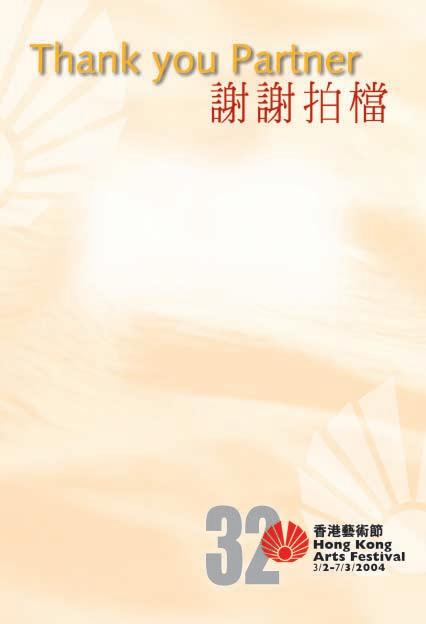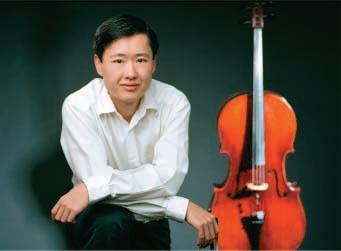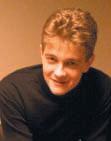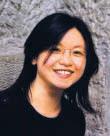Your support and sponsorship has made possible the Festival attraction Chui-Yee Lee Cello Recital . With grateful thanks from the Hong Kong Arts Festival.
We wish you and your guests a very enjoyable evening.
多謝您們的贊助及支持,使 李垂誼大提琴演奏會 得以順利在香港藝術節演出。
希望您們有一個愉快的晚上。
14.2.2004
香港大會堂音樂廳
Hong Kong City Hall Concert Hall
李垂誼大提琴演奏會
Chui-Yee Lee Cello Recital
演出長約1小時35分鐘,包括一節15分鐘中場休息
Running time: approximately 1 hour and 35 minutes, including a 15 minute interval
節目詳情
For programme details Page 22 頁
為了讓大家對這次演出留下美好印象,請切記在節目開始前關掉手錶、無㵟電話及傳呼機的響鬧裝 置。會場內請勿擅自攝影、錄音或錄影,亦不可飲食和吸煙,多謝合作。
To make this performance a pleasant experience for the artists and other members of the audience, PLEASE switch off your alarm watches, MOBILE PHONES and PAGERS. Eating and drinking, unauthorised photography and audio or video recording are forbidden in the auditorium. Thank you for your co-operation.
李垂誼
2004 年楊尼格洛國際大提琴比賽冠軍李垂 誼,代表了新一代敏銳、成熟、理解力超卓 的音樂家。
自2000年起,李垂誼已經贏得三大世界大提 琴比賽 紐約南堡格、赫爾辛基國際保 爾路大提琴大賽以及第五十五屆日內瓦國際 音樂大賽的獎項,是首位在這幾項國際大賽 中奪得殊榮的香港大提琴家。
李垂誼九歲起學習大提琴,十二歲考進茱莉 亞音樂學院,師隨艾迪夫.艾爾頓。不用三 年,李垂誼在茱莉亞音樂學院先修班樂團及 室樂團於林肯中心的音樂會,首次擔任獨 奏,又奪得費城協奏曲獨奏大賽首獎,以及 在第三屆奧格.科塞維斯基大賽中掄元,為 該項比賽最年輕的優勝者。
大學時期,李垂誼在哈佛大學修讀經濟 學,獲學士學位。當了財務策略顧問一年 後,發現始終鍾情大提琴,乃入讀紐英倫
音樂學院,隨著名大提琴家,亦為加斯 柏.卡沙度門生的羅倫斯.歷沙深造大提 琴,並取得碩士學位。
李垂誼曾在各大音樂廳及音樂節演出,包 括馬德里的國家音樂廳及萬寶路音樂節; 並多次在電視亮相,包括在莫斯科克里姆 林宮的獨奏演出、克羅地亞林辛斯基音樂 廳獨奏及樂團演出,以及美國有線電視新 聞網及芬蘭電視台的專訪。李垂誼也活躍 於室樂演奏,曾與多位著名音樂家如大提 琴家馬利奧.布倫尼洛、小提琴大師艾菲 力.紀特歷斯和古亞納利四重奏的大提琴 手大衛.索亞合作。近期演出包括與芬蘭 電台交響樂團及克羅地亞薩格勒布愛樂樂 團合作,並於多個國家及地區舉行獨奏 會,包括俄羅斯(莫斯科春季音樂節)、德 國、法國、台北等。
最近李垂誼在西班牙和德國追隨瑞典大提 琴家和指揮家法蘭斯.赫爾莫遜學習。
Chui-Yee Lee
Winner of the first prize at the 2004 International Antonio Janigro Cello Competition in Croatia, Chui-Yee Lee represents a new generation of artists that symbolise sensitivity, sophistication and intelligence in the practice of their art.
Since 2000, Lee has firmly established himself as a world class musician by winning three prestigious international competitions – New York’s Naumburg, Helsinki’s International Paulo Cello, and the 55th Geneva International Music Competition.
Chui-Yee Lee began to play the cello at age nine and entered the Juilliard School at age 12 studying with Ardyth Alton. Within three years, Lee made his orchestral solo debut at the Lincoln Center with the Juilliard Pre-College Orchestra and Chamber Orchestra, and won first prizes at Philadelphia’s Concerto Soloist Competition, and the 3rd Olga Koussevitsky Competition, where he was also the youngest prize-winner.
Lee gained a Bachelor’s degree in economics from Harvard University and went on to work for a year as a management consultant, before deciding his passion
remained the cello. He then studied at the New England Conservatory, earning a Master’s degree in music under renowned cellist Laurence Lesser, who was a student of the late legerdary cellist and composer Gaspar Cassado.
Lee has performed extensively in major venues and festivals, including Madrid’s Auditorio Nacional and the Marlboro Music Festival. His televised concerts include a solo appearance at the Kremlin in Moscow, recital and orchestral appearences at Vatroslav Lisinski Concert Hall in Croatia and feature interviews with CNN and Finnish Television.
As an active chamber musician, Lee has also collaborated with many renowned artists like cellist Mario Brunello and violin virtuosi Ivry Gitlis and David Soyer of the Guarneri Quartet. Recent appearances have included performances with the Finnish Radio Symphony, the Zagreb Philharmonic Orchestra and recitals held in d ifferent countries, such as Russia (the Moscow Spring Festival), Germany, France, and Taipei.
He has recently been under the tutelage of Swedish cellist and conductor Frans Helmerson in Spain and Germany.
大師班 Masterclass
21.2.2004(六 Sat)上午11:30 am - 下午1:00 pm
香港演藝學院音樂廳 Hong Kong Academy for Performing Arts Concert Hall
合辦:香港演藝學院 Co-presented with Hong Kong Academy for Performing Arts
鄧慧中 Joyce Wai-chung Tang
作曲家 Composer
鄧慧中在香港出生,香港浸會大學畢業,獲文學碩士(作 曲)及哲學碩士(電子-原音樂)學位,及後負笈巴黎,於音 樂及聲學研究中心深造,現正修讀香港大學音樂學博士 學位。
鄧慧中作品曾獲選於多個主要當代音樂節及音樂會議中演 出,包括國際當代音樂協會和英國世界音樂日。近作包括 香港城市室樂團委約的《醉花陰》(女高音和室樂組)。
除了作曲,鄧慧中也涉獵視覺藝術,其書法曾在香港、澳 門、日本及美國等地展覽及出版。
Born in Hong Kong, Joyce Tang obtained a Master’s in Composition and an MPhil in electro-acoustic music at Hong Kong Baptist University. She later joined the Summer Academy of the Institut de Recherche et Coordination Acoustique/Music (IRCAM) in Paris to further her studies. She is currently pursuing a doctoral degree in musicology at the University of Hong Kong.
Her compositions have been jury-selected for performances in major contemporary music festivals and conferences, such as the International Society for Contemporary Music World Music Days in the UK. A recently commissioned piece was Drunk With Flower Shadows, for soprano and chamber ensemble, by the City Chamber Orchestra of Hong Kong.
As well as composing, Joyce Tang is involved in the visual arts. Her calligraphy has been featured in several exhibitions and publications in Hong Kong, Macau, Japan, and the US.
梁靄凝 Oi-ying Leung
古箏 Zheng
梁靄凝自幼習音樂, 1997 年香港演藝學院畢業,以優異成 績獲取音樂學士學位。梁氏曾獲頒成龍獎學金,並多次赴 海外演出。
除了熱中於中國民族音樂,梁氏亦經常演奏香港作曲家的 作品,以推廣本地創作。 1997 年她應臨時區域巿政局的邀 請主辦獨奏會, 1998 年為香港電台第四台的駐台演奏家之 一。2002 年8
月,梁氏參與於阿根廷舉行的第三十四屆國際 交流藝術節及第五屆布宜諾斯艾利斯國際音樂節演出。
Born in Hong Kong, Oi-ying Leung has studied music since childhood and graduated with distinction from the Hong Kong Academy for Performing Arts with a Bachelor of Fine Arts in 1997. She was awarded the Jackie Chan Scholarship and took part in a number of overseas performances.
Apart from her interest in traditional Chinese music, Leung also performs works by Hong Kong composers, making every endeavour to promote local compositions. In 1997 she held a recital presented by the Provisional Regional Council and in 1998 she was one of the Artists-in-Residence for the Hong Kong Radio 4. In August 2002, Leung performed in the 34th Festival Internacional Encuentros and the 5th Festival Internacional de Musica de Buenos Aires in Argentina.
節目
加斯柏.卡沙度
大提琴獨奏組曲 前奏曲(行板)
幻想曲(稍快)
沙爾拉拿舞曲(嚴格的快板) 間奏曲(不太慢的緩板)及
最後的舞曲(突出的快板)
鄧慧中 《伸弦》(給大提琴及箏)
布拉姆斯
D 大調奏鳴曲,作品 78 不太快的極快板 慢板 近似行板 開首的慢板 中庸的快板
-中場休息十五分鐘
舒曼
降 A 大調慢板及快板, 作品 70
李察.史特勞斯 F 大調奏鳴曲,作品 6 光輝的快板 不太快的行板 終曲(活潑的快板)
巴托
狂想曲(為大提琴及鋼琴改編),作品 94c 中板 中庸的小快板 快板 極急板 回到第一部份的速度(中板) 彈性速度,類似華采樂段
Programme
Gasper Cassado
Suite for Cello Solo
Preludio (Andante)
Fantasia (Poco più mosso)
Sardana (Allegro giusto)
Intermezzo (Lento ma non troppo) e danxa finale (Allegro marcato)
Joyce Wai-chung Tang
Stretch for Cello and Zheng
Johannes Brahms
Sonata in D major, Op 78
Vivace non troppo
Adagio Più andante Adagio come prima
Allegro molto moderato
15 minute interval –
Robert Schumann
Adagio and Allegro in A flat major, Op 70
Richard Strauss
Sonata in F major, Op 6
Allegro con brio
Andante ma non troppo
Finale (Allegro vivo)
Béla Bartók
Rhapsody for Cello and Piano, Op 94c
Moderato
Allegretto moderato Allegro
Vivacissimo Tempo della I. Parte (Moderato) Rubato, quasi cadenza
鋼琴 亨利.布拿美 古箏 梁靄凝
Henri Bonamy Piano
Oi-ying Leung Zheng
大提琴獨奏組曲
加斯柏.卡沙度 (1897-1966)
卡沙度於巴塞隆拿出生,七歲學習大 提琴,少年時代留學巴黎,師承加泰 羅尼亞大提琴家卡薩爾斯,並隨拉威 爾及德法利亞學習作曲。
二十世紀二、三十年代,卡沙度經常 以大提琴家的身份巡迴演出,合作指 揮包括比徹姆和福特溫格勒。 1936 年 以後,卡沙度一直留在意大利,名作 包括題獻給卡薩爾斯的大提琴協奏 曲,以及加泰羅尼亞狂想曲 (1928) 。
跟巴赫的獨奏大提琴組曲一樣,卡沙 度的組曲也由多首舞曲組成:包括前 奏曲况的「薩拉邦舞曲」、加泰羅尼亞 的圓環舞曲〈沙爾拉拿舞曲〉,還有終 樂章風格奇特,格調帶點哀愁的五/ 四拍子舞曲。
《伸弦》(給大提琴及箏)
鄧慧中
此作品並非表達高深哲學或複雜思 維,就如作曲家夏理遜曾經說過:「音 樂是一歌一舞。」此作品結構正是如 此:頭尾兩段以 estampie(十三、十四 世紀歐洲器樂舞曲)的形式,包裹着中 間部份一段如歌的素材。可能本人近 來接觸夏理遜的作品,從而啟發對古 老舞曲形式的興趣;在與李垂誼的對 話中,我得知他在香港的童年回憶, 從而啟發創作如歌的部份。
樂曲介紹由作曲家提供
Suite for Cello Solo
Gaspar Cassado (1897-1966)
Gaspar Cassado was born in Barcelona, and began studying the cello at the age of seven. In his teens, he studied in Paris with the Catalonian cellist Pau (Pablo) Casals, and took composition lessons with Maurice Ravel and Manuel de Falla.
As a concert cellist, he toured widely in the 1920s and 1930s, performing with conductors such as Beecham and Furtwangler. For the last 30 years of his life he lived in Italy. His works include a Cello Concerto , dedicated to Casals, and the Rapsodía Catalana (1928).
Like Bach’s solo cello suites, Cassado’s Suite is based on dance forms, including a sarabande in the Prelude, the Catalonian circle dance, Sardana, and a curious wistful dance in 5/4 time in the finale.
《伸弦》(給大提琴及箏)由第三十二屆 香港藝術節委約,並由香港作曲家及 作詞家協會音樂基金贊助。
Stretch for Cello and Zheng Joyce Wai-chung Tang
This piece is not about sophisticated philosophy or complicated thoughts. As composer Lou Harrison once said, “Music is a song and a dance”. The structure of this piece revolves around just that: two outer sections of an estampie-like dance embracing a lyrical song-like section in the middle. Perhaps my recent study of Harrison’s works stimulated me to write an estampie type of a dance. The song is inspired by the conversation that I had with Chui-Yee, who told me about his childhood memories in Hong Kong.
Programme note provided by the composer
Stretch for Cello and Zheng is commissioned by the 2004 Hong Kong Arts Festival with sponsorship from CASH Music Fund.
D 大調奏鳴曲,作品
78
布拉姆斯 (1833-1897)
第二交響曲及第一小提琴奏鳴曲同是 布拉姆斯在波特撒克創作的作品。小 提琴奏鳴曲寫於 1878 和 1879 年夏季, 而第二交響曲則於較早前完成。
友人形容第二交響曲「滿是涓涓溪流、 朗日藍天、綠樹成蔭 波特撒克該 是何等優美!」而這首奏鳴曲的開端也 頗得其趣。在鋼琴晶瑩通透、變化多 端的輕柔伴奏下,獨奏者的旋律彷彿 自由自在地漫遊,使得蕭伯納(並非布 拉姆斯的擁護者呢!)也說這段「雖然 傻兮兮的,但無法抗拒」。
第二樂章的間奏曲華麗精緻,中段速 度較快,形成對比。終樂章以小調作 開端;第二樂章第一主題稍後重現, 但以華麗的三度和六度音重新修飾。
-中場休息十五分鐘
Sonata in D major, Op 78
Johannes Brahms (1833-1897)
Brahms worked on his first violin sonata in Pörtschach over the summer holidays of 1878 and 1879. Previously he had composed his Second Symphony there, a work a friend had described as “all rippling streams, blue sky, sunshine, and cool green shadows. How beautiful it must be at Pörtschach!”
The Sonata’s opening has something of the same spirit. The soloist’s free-ranging melodic stream is gently coloured by the translucent, everchanging piano part. George Bernard Shaw (no great fan of Brahms) described it as “addleheaded, but irresistible”.
The second movement is a rich intermezzo with a faster contrasting central episode. The finale at first veers to the minor side. At its centre the opening theme of the second movement returns, rescored in luscious thirds and sixths.
15 minute interval –
降 A 大調慢板及快板,
作品 70
舒曼 (1810-1856)
舒曼寫作此曲初期,打算以《浪漫曲》 為題 因為樂曲格調,充滿恬靜愉 快的森林氣息,是當時德國民間文化 的典型。
樂曲原以圓號這最富森林氣息的樂器 演奏,但舒曼為了增加樂曲的演奏機 會,鼓勵其他「次中音」樂器(如中提 琴、大提琴)演奏家也去演奏此曲目。
〈快板〉的三連音標明要「快速、激情」 地演奏,令人聯想到狩獵的情景,即 使用弦樂器也一樣活靈活現。此曲 1849 年2 月寫於德累斯頓,兩個月後革 命爆發;樂曲反映出的,正是政局動 盪前夕最後的平靜時刻。
F 大調奏鳴曲,作品 6
李察.史特勞斯 (1864-1949)
李察.史特勞斯的父親法蘭茲.史特 勞斯,是專業的圓號手,難怪李察. 史特勞斯不少早期作品都是為「次中 音」樂器而寫的,著名的包括圓號協奏 曲 (1882) 、大提琴和樂團的浪漫曲 (1883) ,還有這首大提琴奏鳴曲。
史特勞斯對大提琴情有獨鍾,大概受 到好友漢斯.韋漢影響。這首大提琴 奏鳴曲正是題獻給韋漢的(後來德伏扎 克也把一首大提琴協奏曲題獻給 韋漢)。
Adagio and Allegro in A flat major, Op 70
Robert Schumann (1810-1856)
Schumann’s first thought for a title when sketching this short work was Romanze, which given the moods of the work itself suggests a forest idyll so typical of German folk culture of the time.
The piece was conceived for the archetypal forest instrument, the horn, but with an eye to greater utility, Schumann encouraged performers on two other “tenor” range instruments, the viola and cello, also to take it into their repertoire. Even on string instruments, the triplets in the Allegro, marked “fast and fiery”, are evocative of the hunt. Composed in Dresden in February 1849, the work reflects the last moments of peace in the city before the great political uprising there two months later.
Sonata in F major, Op 6
Richard Strauss (1864-1949)
Richard Strauss’s father, Franz, was a professional horn player and it is perhaps not surprising therefore, that several of his earliest works were composed for “tenor” instruments, notably a Concerto for the horn itself (1882), a Romanza for cello and orchestra (1883), and this Cello Sonata.
Strauss’s special feeling for the cello was encouraged by his friendship with Hans Wihan, to whom the sonata is dedicated (later Dvoˇrák would also dedicate his Cello Concerto to Wihan).
史特勞斯寫作此曲時,還在大學唸 書,而此曲也是他早期傑作之一;首 演由史特勞斯和一位同學合奏,根據 史特勞斯向雙親描述,曲終時觀眾報 以「狂熱的掌聲」。
狂想曲(為大提琴及鋼琴
改編),作品 94c 巴托 (1881-1945)
這首狂想曲本來由小提琴及鋼琴合 奏,但1929年3 月20 日首演的,卻是大 提琴與鋼琴版本,由巴托本人和揚 諾.克柏利合奏。
第一次世界大戰前,巴托在特斯雲尼 亞、羅馬尼亞和匈牙利等地實地考 察,蒐集民歌;而這首狂想曲,可說 是巴托在當地搜集的民歌旋律的「雜錦 曲」。樂曲由兩個相連的部份組成:第 一部份(慢速)由羅馬尼亞「徵兵舞」旋 律掀開序幕,隨後引用了匈牙利民歌 旋律,然後「徵兵舞」旋律重現。第二 部份(快速)先引用了羅馬尼亞「棍杖 舞」;隨後的舞曲效果類似風笛;而奔 放的圓環舞曲,則旋風似地將音樂捲 向高潮,戛然而止。在第一部份的慢 速開端重現過後,引入結尾的華采 樂段。
除特別註明,所有樂曲介紹: 格雷姆.史堅拿 中譯:鄭曉彤
Composed while Strauss was still a university student, it remained one of the proudest achievements of his early career and was rewarded with “tumultuous applause” (as the composer assured his parents) when he and a fellow student first performed it.
Rhapsody for Cello and Piano, Op 94c
Béla Bartók (1881-1945)
Though originally composed for violin and piano, this Rhapsody was actually first heard in this version for cello, performed by Bartók and Jenö Kerpely on 20 March 1929.
The Rhapsody is a pot-pourri of folk tunes selected by Bartók from Transylvanian, Rumanian and Hungarian melodies he collected on fieldtrips before the First World War. They are arranged in two linked parts.
The first (slow) part opens with a Rumanian verbunkos melody, followed by a Hungarian melody, and a reprise of the opening tune. The second (fast) part begins with a Rumanian “stick dance”. The next dance recalls bagpipe music, followed by a wild round dance whirling to a climax. Suddenly it stops and the music returns to the slow opening of the first part, leading into a closing cadenza.
Unless otherwise specified, all programme notes are by Graeme Skinner.






